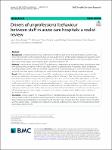Drivers of unprofessional behaviour between staff in acute care hospitals: a realist review
| dc.contributor.author | Aunger, JA | |
| dc.contributor.author | Maben, J | |
| dc.contributor.author | Abrams, R | |
| dc.contributor.author | Wright, JM | |
| dc.contributor.author | Mannion, R | |
| dc.contributor.author | Pearson, M | |
| dc.contributor.author | Jones, A | |
| dc.contributor.author | Westbrook, JI | |
| dc.date.accessioned | 2023-12-01T09:47:36Z | |
| dc.date.available | 2023-12-01T09:47:36Z | |
| dc.date.issued | 2023-11-30 | |
| dc.identifier.issn | 1472-6963 | |
| dc.identifier.issn | 1472-6963 | |
| dc.identifier.other | 1326 | |
| dc.identifier.uri | https://pearl.plymouth.ac.uk/handle/10026.1/21762 | |
| dc.description.abstract |
Background Unprofessional behaviours (UB) between healthcare staff are rife in global healthcare systems, negatively impacting staff wellbeing, patient safety and care quality. Drivers of UBs include organisational, situational, team, and leadership issues which interact in complex ways. An improved understanding of these factors and their interactions would enable future interventions to better target these drivers of UB. Methods A realist review following RAMESES guidelines was undertaken with stakeholder input. Initial theories were formulated drawing on reports known to the study team and scoping searches. A systematic search of databases including Embase, CINAHL, MEDLINE and HMIC was performed to identify literature for theory refinement. Data were extracted from these reports, synthesised, and initial theories tested, to produce refined programme theories. Results We included 81 reports (papers) from 2,977 deduplicated records of grey and academic reports, and 28 via Google, stakeholders, and team members, yielding a total of 109 reports. Five categories of contributor were formulated: (1) workplace disempowerment; (2) harmful workplace processes and cultures; (3) inhibited social cohesion; (4) reduced ability to speak up; and (5) lack of manager awareness and urgency. These resulted in direct increases to UB, reduced ability of staff to cope, and reduced ability to report, challenge or address UB. Twenty-three theories were developed to explain how these contributors work and interact, and how their outcomes differ across diverse staff groups. Staff most at risk of UB include women, new staff, staff with disabilities, and staff from minoritised groups. UB negatively impacted patient safety by impairing concentration, communication, ability to learn, confidence, and interpersonal trust. Conclusion Existing research has focused primarily on individual characteristics, but these are inconsistent, difficult to address, and can be used to deflect organisational responsibility. We present a comprehensive programme theory furthering understanding of contributors to UB, how they work and why, how they interact, whom they affect, and how patient safety is impacted. More research is needed to understand how and why minoritised staff are disproportionately affected by UB. | |
| dc.format.extent | 1326- | |
| dc.format.medium | Electronic | |
| dc.language | en | |
| dc.publisher | Springer Science and Business Media LLC | |
| dc.subject | Acute health care | |
| dc.subject | Bullying | |
| dc.subject | Incivility | |
| dc.subject | Organisational culture | |
| dc.subject | Patient safety | |
| dc.subject | Professionalism | |
| dc.subject | Psychological safety | |
| dc.subject | Psychological wellbeing | |
| dc.subject | Unprofessional behaviour | |
| dc.subject | Workforce | |
| dc.subject | Female | |
| dc.subject | Humans | |
| dc.subject | Delivery of Health Care | |
| dc.subject | Hospitals | |
| dc.subject | Learning | |
| dc.subject | Professional Misconduct | |
| dc.subject | Workplace | |
| dc.title | Drivers of unprofessional behaviour between staff in acute care hospitals: a realist review | |
| dc.type | journal-article | |
| dc.type | Journal Article | |
| dc.type | Systematic Review | |
| plymouth.author-url | https://www.ncbi.nlm.nih.gov/pubmed/38037093 | |
| plymouth.issue | 1 | |
| plymouth.volume | 23 | |
| plymouth.publisher-url | http://dx.doi.org/10.1186/s12913-023-10291-3 | |
| plymouth.publication-status | Published online | |
| plymouth.journal | BMC Health Services Research | |
| dc.identifier.doi | 10.1186/s12913-023-10291-3 | |
| plymouth.organisational-group | |Plymouth | |
| plymouth.organisational-group | |Plymouth|Faculty of Health | |
| plymouth.organisational-group | |Plymouth|Faculty of Health|School of Nursing and Midwifery | |
| plymouth.organisational-group | |Plymouth|REF 2021 Researchers by UoA | |
| plymouth.organisational-group | |Plymouth|Users by role | |
| plymouth.organisational-group | |Plymouth|Users by role|Academics | |
| plymouth.organisational-group | |Plymouth|REF 2021 Researchers by UoA|UoA03 Allied Health Professions, Dentistry, Nursing and Pharmacy | |
| plymouth.organisational-group | |Plymouth|REF 2028 Researchers by UoA | |
| plymouth.organisational-group | |Plymouth|REF 2028 Researchers by UoA|UoA03 Allied Health Professions, Dentistry, Nursing and Pharmacy | |
| dc.publisher.place | England | |
| dcterms.dateAccepted | 2023-11-07 | |
| dc.date.updated | 2023-12-01T09:47:34Z | |
| dc.rights.embargodate | 2023-12-2 | |
| dc.identifier.eissn | 1472-6963 | |
| rioxxterms.versionofrecord | 10.1186/s12913-023-10291-3 |


